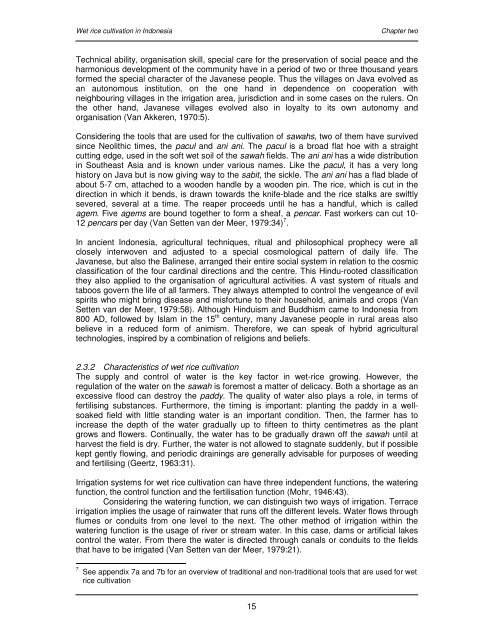Wet rice cultivation in Indonesia - Free EBooks Library
Wet rice cultivation in Indonesia - Free EBooks Library
Wet rice cultivation in Indonesia - Free EBooks Library
Create successful ePaper yourself
Turn your PDF publications into a flip-book with our unique Google optimized e-Paper software.
<strong>Wet</strong> <strong>rice</strong> <strong>cultivation</strong> <strong>in</strong> <strong>Indonesia</strong> Chapter two<br />
Technical ability, organisation skill, special care for the preservation of social peace and the<br />
harmonious development of the community have <strong>in</strong> a period of two or three thousand years<br />
formed the special character of the Javanese people. Thus the villages on Java evolved as<br />
an autonomous <strong>in</strong>stitution, on the one hand <strong>in</strong> dependence on cooperation with<br />
neighbour<strong>in</strong>g villages <strong>in</strong> the irrigation area, jurisdiction and <strong>in</strong> some cases on the rulers. On<br />
the other hand, Javanese villages evolved also <strong>in</strong> loyalty to its own autonomy and<br />
organisation (Van Akkeren, 1970:5).<br />
Consider<strong>in</strong>g the tools that are used for the <strong>cultivation</strong> of sawahs, two of them have survived<br />
s<strong>in</strong>ce Neolithic times, the pacul and ani ani. The pacul is a broad flat hoe with a straight<br />
cutt<strong>in</strong>g edge, used <strong>in</strong> the soft wet soil of the sawah fields. The ani ani has a wide distribution<br />
<strong>in</strong> Southeast Asia and is known under various names. Like the pacul, it has a very long<br />
history on Java but is now giv<strong>in</strong>g way to the sabit, the sickle. The ani ani has a flad blade of<br />
about 5-7 cm, attached to a wooden handle by a wooden p<strong>in</strong>. The <strong>rice</strong>, which is cut <strong>in</strong> the<br />
direction <strong>in</strong> which it bends, is drawn towards the knife-blade and the <strong>rice</strong> stalks are swiftly<br />
severed, several at a time. The reaper proceeds until he has a handful, which is called<br />
agem. Five agems are bound together to form a sheaf, a pencar. Fast workers can cut 10-<br />
12 pencars per day (Van Setten van der Meer, 1979:34) 7 .<br />
In ancient <strong>Indonesia</strong>, agricultural techniques, ritual and philosophical prophecy were all<br />
closely <strong>in</strong>terwoven and adjusted to a special cosmological pattern of daily life. The<br />
Javanese, but also the Bal<strong>in</strong>ese, arranged their entire social system <strong>in</strong> relation to the cosmic<br />
classification of the four card<strong>in</strong>al directions and the centre. This H<strong>in</strong>du-rooted classification<br />
they also applied to the organisation of agricultural activities. A vast system of rituals and<br />
taboos govern the life of all farmers. They always attempted to control the vengeance of evil<br />
spirits who might br<strong>in</strong>g disease and misfortune to their household, animals and crops (Van<br />
Setten van der Meer, 1979:58). Although H<strong>in</strong>duism and Buddhism came to <strong>Indonesia</strong> from<br />
800 AD, followed by Islam <strong>in</strong> the 15 th century, many Javanese people <strong>in</strong> rural areas also<br />
believe <strong>in</strong> a reduced form of animism. Therefore, we can speak of hybrid agricultural<br />
technologies, <strong>in</strong>spired by a comb<strong>in</strong>ation of religions and beliefs.<br />
2.3.2 Characteristics of wet <strong>rice</strong> <strong>cultivation</strong><br />
The supply and control of water is the key factor <strong>in</strong> wet-<strong>rice</strong> grow<strong>in</strong>g. However, the<br />
regulation of the water on the sawah is foremost a matter of delicacy. Both a shortage as an<br />
excessive flood can destroy the paddy. The quality of water also plays a role, <strong>in</strong> terms of<br />
fertilis<strong>in</strong>g substances. Furthermore, the tim<strong>in</strong>g is important: plant<strong>in</strong>g the paddy <strong>in</strong> a wellsoaked<br />
field with little stand<strong>in</strong>g water is an important condition. Then, the farmer has to<br />
<strong>in</strong>crease the depth of the water gradually up to fifteen to thirty centimetres as the plant<br />
grows and flowers. Cont<strong>in</strong>ually, the water has to be gradually drawn off the sawah until at<br />
harvest the field is dry. Further, the water is not allowed to stagnate suddenly, but if possible<br />
kept gently flow<strong>in</strong>g, and periodic dra<strong>in</strong><strong>in</strong>gs are generally advisable for purposes of weed<strong>in</strong>g<br />
and fertilis<strong>in</strong>g (Geertz, 1963:31).<br />
Irrigation systems for wet <strong>rice</strong> <strong>cultivation</strong> can have three <strong>in</strong>dependent functions, the water<strong>in</strong>g<br />
function, the control function and the fertilisation function (Mohr, 1946:43).<br />
Consider<strong>in</strong>g the water<strong>in</strong>g function, we can dist<strong>in</strong>guish two ways of irrigation. Terrace<br />
irrigation implies the usage of ra<strong>in</strong>water that runs off the different levels. Water flows through<br />
flumes or conduits from one level to the next. The other method of irrigation with<strong>in</strong> the<br />
water<strong>in</strong>g function is the usage of river or stream water. In this case, dams or artificial lakes<br />
control the water. From there the water is directed through canals or conduits to the fields<br />
that have to be irrigated (Van Setten van der Meer, 1979:21).<br />
7 See appendix 7a and 7b for an overview of traditional and non-traditional tools that are used for wet<br />
<strong>rice</strong> <strong>cultivation</strong><br />
15








